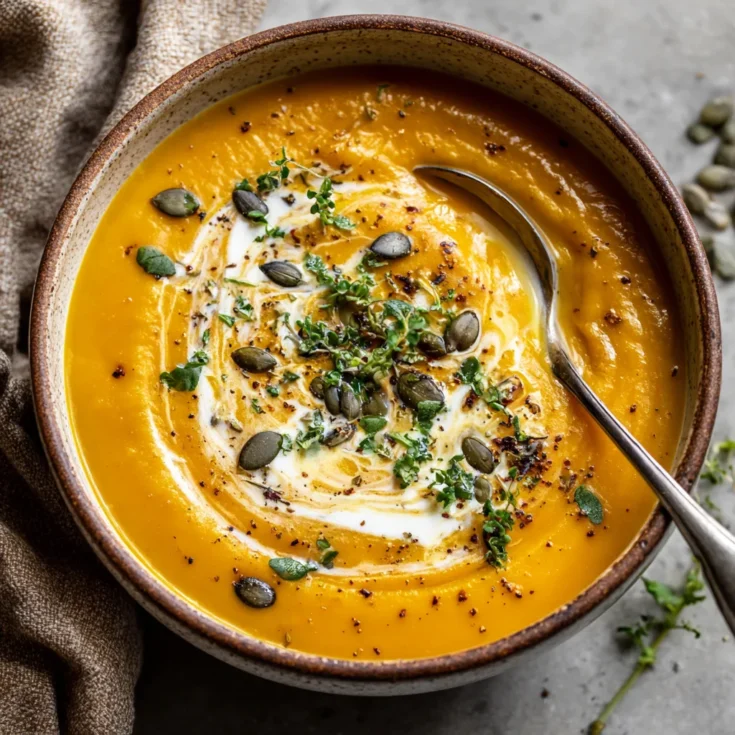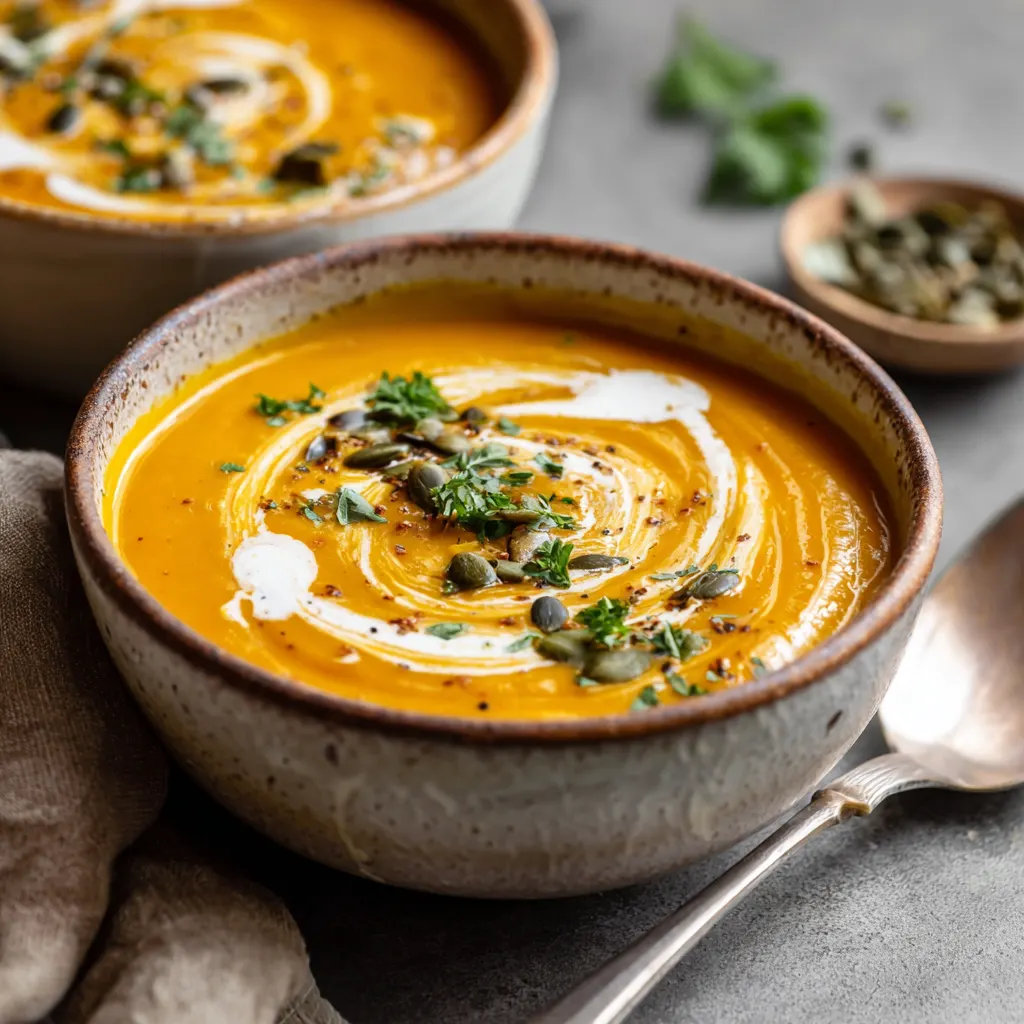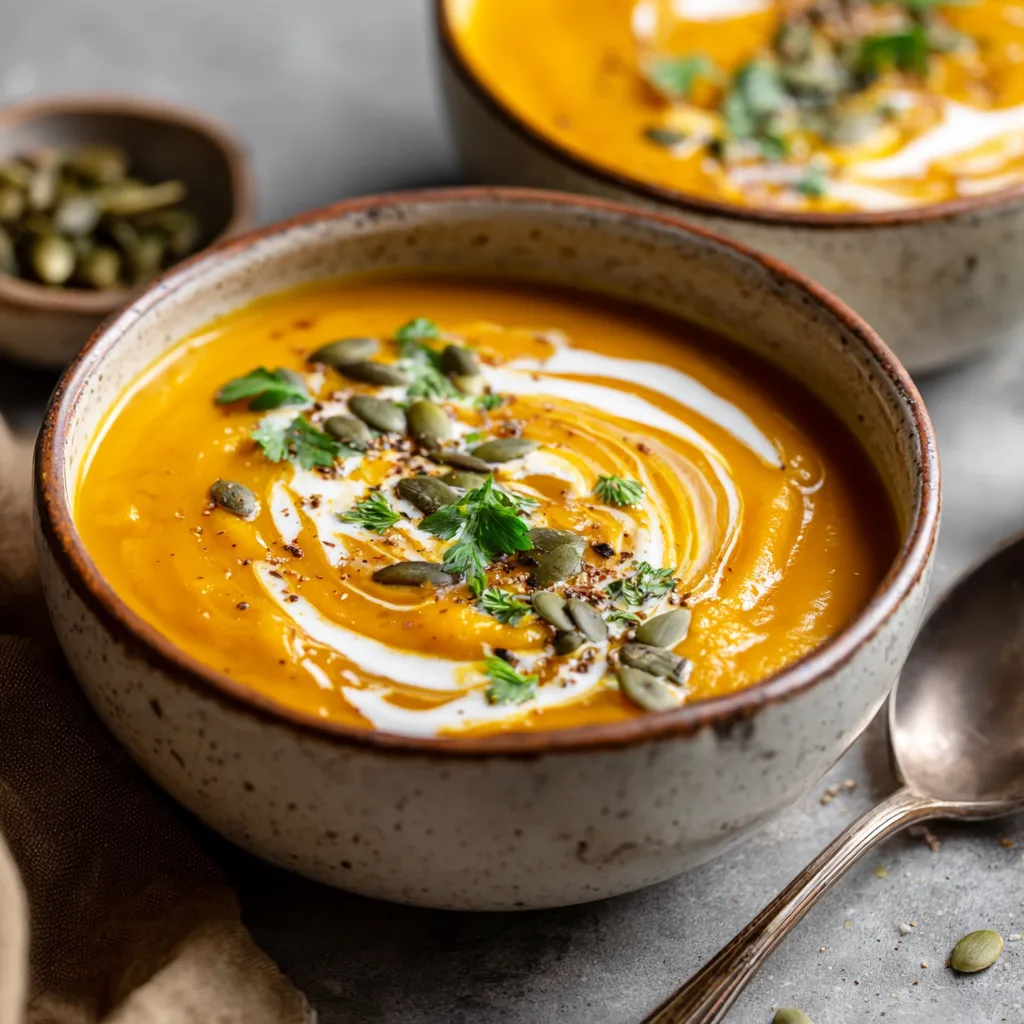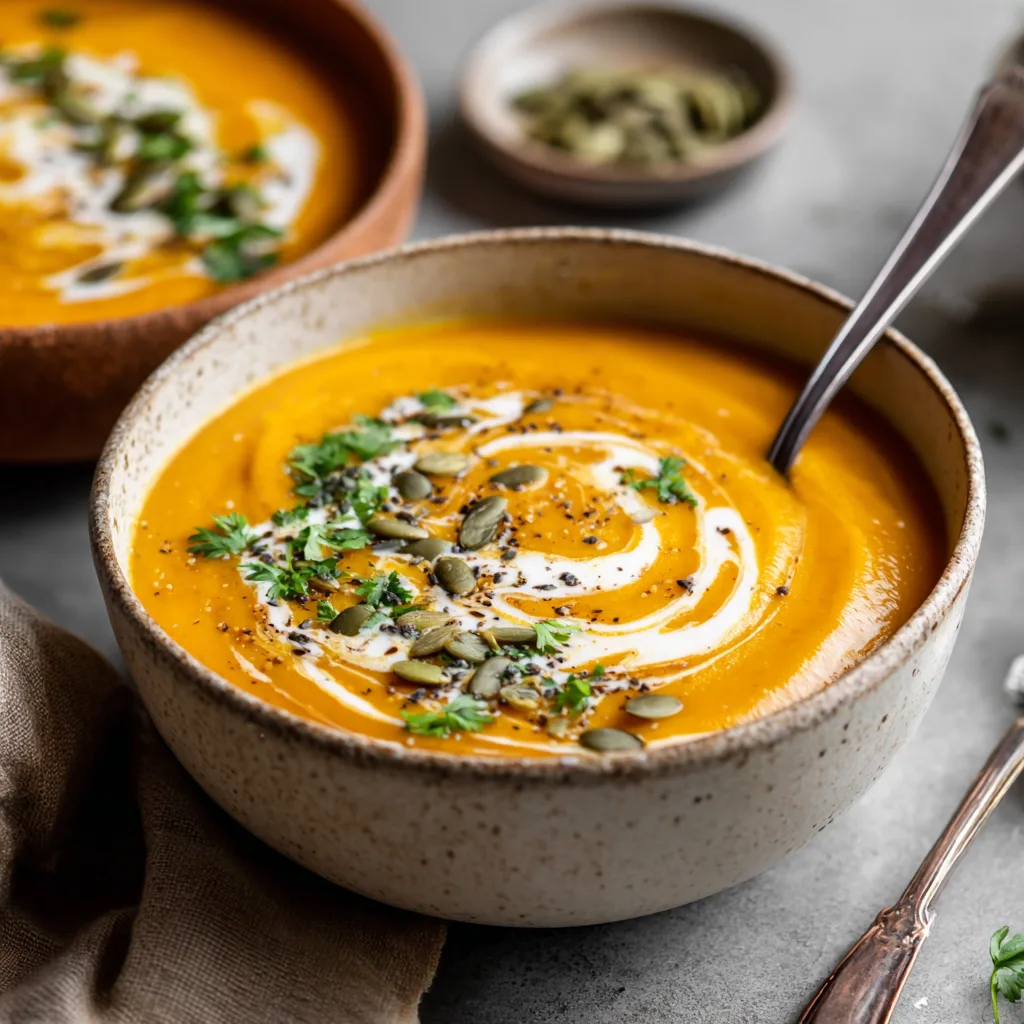When the air turns crisp and sweaters come out of storage, there’s no better way to warm up than with a bowl of pumpkin soup. This cozy dish not only celebrates fall flavors—it caters to specific dietary needs, too. A one‑pot gluten‑free pumpkin soup offers the perfect balance of simplicity, comfort, and nutrition. Whether you’re avoiding gluten for medical reasons or prefer meals with minimal cleanup, this soup checks all the boxes. It’s fast, flexible, and family‑friendly.
Why “One‑Pot” and Why “Gluten‑Free” Matter
Life moves fast. A one‑pot meal saves precious time and cuts dishwashing in half. Everything cooks in one vessel, from sautéing aromatics to simmering the soup.
Now add a gluten‑free twist. For those with celiac disease or gluten intolerance, every ingredient matters. This recipe keeps things safe, avoiding cross-contamination and suspicious thickeners. The result is a meal that’s simple to prepare and easy to digest—without sacrificing flavor or texture.
What You’ll Learn
In this guide, you’ll discover how to make a one‑pot pumpkin soup that’s naturally gluten‑free. You’ll learn the key ingredients, explore delicious variations, and walk through each step clearly. A printable recipe card wraps it all up for easy reference.
Quick Overview of Top Recipe Trends
The internet is brimming with ways to personalize this seasonal classic. Creamy versions lead the charge—often blending canned or roasted pumpkin with coconut milk or broth. Many recipes go dairy-free and vegan, perfect for plant-based diets.
Some trend toward spice, using curry blends, red pepper, or ginger for a flavor punch. Others keep it classic with thyme, garlic, and onion. A few even roast fresh pumpkin before blending for added depth. With so many takes, one-pot gluten-free pumpkin soup proves versatile and crave-worthy, no matter your taste.
Key Ingredients & Delicious Gluten-Free Variations
Core Ingredients for Every Version
Every great pumpkin soup starts with a handful of core ingredients. Pumpkin comes first—either fresh or canned. Fresh pumpkin adds natural sweetness and a rustic texture. Canned pumpkin, on the other hand, is quick, smooth, and dependable.
Next is the broth. Use gluten-free vegetable or chicken stock as your base. It should be rich, flavorful, and free from additives that may contain gluten.
For aromatics, chopped onions and garlic bring depth. These cook first and build flavor from the bottom up. A source of fat—like olive oil, butter, or full-fat coconut milk—helps everything blend smoothly and gives the soup a creamy finish.
Together, these ingredients form a versatile base. From there, you can personalize the soup to match your dietary needs and flavor preferences.
Gluten‑Free Substitutions and Optional Dietary Tweaks
To keep your soup 100% gluten-free, choose your thickeners and toppings with care. Some recipes call for flour to thicken the soup—gluten-free flour or cornstarch are safe alternatives. Both work well and keep the texture silky.
Want crunch? Try gluten-free croutons or roasted chickpeas on top. They add texture and keep the meal satisfying.
If you’re avoiding dairy, there are easy swaps. Coconut milk gives a creamy feel without milk or cream. Almond milk, oat milk, or cashew cream also work well, depending on your flavor preferences. These choices keep the soup light while maintaining a rich mouthfeel.
With the right swaps, you can serve this soup confidently at any table—whether your guests eat gluten-free, dairy-free, or plant-based.
Flavor Builders and Spice Profiles
Once your base is ready, it’s time to build flavor. Traditional versions use herbs like thyme, sage, nutmeg, or cardamom. These give the soup a warm, comforting taste perfect for fall.
If you like spice, take a curry-inspired route. Add cumin, turmeric, or garam masala. Red curry paste brings heat and complexity for a bold twist.
Aromatics and spices are what transform this dish from simple to standout. Whether you prefer classic or adventurous flavors, there’s a version that hits the mark.
Add‑Ins and Garnishes
Toppings make your soup memorable. Toasted pumpkin seeds or sunflower seeds bring crunch. A swirl of coconut cream adds elegance. Fresh herbs like parsley or cilantro give a pop of color.
For more heat, try a sprinkle of red pepper flakes or sliced chili. Crispy onions or gluten-free croutons also add texture and visual appeal.
Don’t skip the garnish—it’s the final touch that makes your soup look and taste gourmet.
Detailed Technique & Cooking Methods for Perfect One-Pot Pumpkin Soup
Step‑by‑Step One‑Pot Method
This one-pot method keeps things easy while maximizing flavor. Start by heating your oil or butter over medium heat in a large pot. Add chopped onions and minced garlic. Sauté for about five minutes until they become soft and fragrant.
Next, stir in your spices. Toasting them briefly releases their aroma and deepens the flavor. Add the pumpkin—either puree or roasted chunks—and stir to coat it with the aromatics.
Pour in your broth. Use just enough to cover the pumpkin fully. Bring the pot to a gentle boil, then reduce to a simmer. Let it cook uncovered for 15 to 20 minutes. This step allows the flavors to blend and the pumpkin to soften further if needed.
Once everything is tender, remove the pot from the heat. Blend until smooth. Stir in coconut milk or cream at the end for added richness. Your soup is now ready to serve.
Using Fresh Versus Canned Pumpkin
Both fresh and canned pumpkin work beautifully in this recipe. The choice depends on your time and texture preference.
Fresh pumpkin delivers a rich, earthy flavor and a slightly thicker texture. To use it, peel and cube the pumpkin, then roast it in the oven until soft and caramelized. This adds a roasted depth that’s worth the extra step.
Canned pumpkin saves time and offers smooth consistency right out of the can. Make sure you choose pure pumpkin puree, not pie filling, which contains added sugar and spices.
If you have the time, try roasting your pumpkin—it elevates the soup and adds a rustic, homemade feel.
Cooking in Instant Pot or Slow Cooker
Looking for even more convenience? Try using an Instant Pot or a slow cooker.
For the Instant Pot method, use the sauté function to cook your onions and garlic. Add the remaining ingredients, secure the lid, and cook on high pressure for about ten minutes. Quick-release the pressure, then blend and finish with cream or coconut milk.
In a slow cooker, skip the sautéing or do it separately. Add all your ingredients to the pot and cook on low for six to eight hours. This long simmer builds deep flavor, especially when using fresh pumpkin or curry spices.
Both methods let you set it and forget it, which makes meal prep simple.
Pureeing Safely and for Texture
To get that smooth, velvety texture, you’ll need to blend your soup. Use an immersion blender directly in the pot for the easiest cleanup. Blend until the texture is uniform.
If using a countertop blender, let the soup cool slightly first. Fill the blender no more than halfway, vent the lid, and cover it with a kitchen towel. Blend in batches to avoid spills or pressure buildup.
A smooth soup is the goal, but some people like a little texture. You can pulse instead of fully blending if you want some chunkiness left in.
Serving Temperature and Consistency Adjustments
Pumpkin soup tastes best when served hot, but not boiling. If your soup has thickened too much, stir in extra broth or water to loosen it.
If it’s too thin, simmer it uncovered for a few more minutes. The soup will reduce and thicken naturally. Coconut milk or cream also adds body, so add more if needed.
Balance is key—adjust the consistency until you reach the texture you enjoy most.
Nutrition, Storage & Serving Ideas for Gluten-Free Pumpkin Soup
Nutrition Highlights of Gluten-Free Pumpkin Soup
This soup isn’t just comforting—it’s nourishing too. Pumpkin is naturally low in calories and packed with essential nutrients. It delivers a strong dose of vitamin A, thanks to its beta-carotene content. You also get vitamin C, potassium, and fiber in every spoonful.
Using gluten-free ingredients ensures safety for those with celiac disease or gluten sensitivity. By swapping in coconut milk or almond milk, you can make the soup dairy-free or even vegan. This keeps the meal gentle on the stomach while still rich in taste.
Additions like white beans, lentils, or chickpeas can boost the protein content. These extras turn a light soup into a satisfying and balanced meal. It’s a great way to sneak more plant-based protein and fiber into your day without effort.
Whether you’re managing allergies or just eating clean, this soup delivers both flavor and function.
Make‑Ahead, Storage & Freezing Instructions
Gluten-free pumpkin soup stores well, making it perfect for busy weeks. After cooking, let the soup cool to room temperature. Transfer it into airtight containers and refrigerate for three to five days.
If you plan to store it longer, freezing is the way to go. Pour cooled soup into freezer-safe containers or zip bags, leaving space for expansion. Label and date them clearly. It will keep well in the freezer for up to three or four months.
To reheat, thaw overnight in the fridge or warm gently on the stove. Stir as it heats to restore its smooth texture.
What to Serve With It
This soup is versatile and pairs well with a variety of gluten-free sides. For a cozy lunch, serve it with toasted gluten-free bread or crunchy gluten-free croutons.
Looking for something more filling? Try it with a gluten-free grilled cheese sandwich. The creamy soup balances perfectly with the crisp sandwich.
Fresh salads also make great partners. A simple spinach salad with nuts and vinaigrette adds contrast. Or serve the soup with hearty grains like quinoa, rice, or millet for a more complete dinner.
The best part? You can dress it up or keep it simple—it always satisfies.
FAQs About One‑Pot Gluten‑Free Pumpkin Soup
Is pumpkin soup gluten‑free?
Pumpkin soup can be gluten‑free, but only if every ingredient is safe. Always check your broth, spices, and any thickening agents. Some store-bought stocks and spice blends may contain gluten or have cross-contact risks. Use verified gluten‑free products to keep the recipe safe for those with celiac disease or gluten sensitivity.
Can I make pumpkin soup vegan or dairy‑free?
Absolutely. For a vegan or dairy‑free version, swap regular broth with vegetable broth. Instead of cream or dairy milk, use coconut milk, almond milk, or another plant-based alternative. These choices keep the soup rich and satisfying while staying free from animal products or dairy allergens.
What’s the best pumpkin to use (fresh vs canned)?
Fresh pumpkin offers a deeper, roasted flavor and a slightly rustic texture. It’s great if you want that homemade, earthy touch. Canned pumpkin is smooth, reliable, and quick to use. It’s perfect for busy days when you want consistency without the prep. Either works—the choice depends on your schedule and taste.
How do I thicken or thin the soup?
To thicken your soup, simmer it uncovered for a few extra minutes. This reduces the liquid and concentrates flavor. For a creamier texture, you can also stir in more coconut milk or a thickening agent like gluten-free flour. If it’s too thick, just add a splash of broth or water until the texture feels right.
Can I freeze this soup?
Yes, pumpkin soup freezes very well. Let it cool completely, then store it in an airtight container or freezer-safe bag. Label it with the date and freeze for up to three or four months. When ready to enjoy, thaw it overnight in the fridge and reheat slowly on the stove, stirring to bring back its silky texture.
One-Pot Gluten-Free Pumpkin Soup – Easy, Creamy & Cozy Fall Favorite

A creamy, flavorful pumpkin soup made in one pot—easy, comforting, and safe for gluten‑free diets.
Ingredients
- 2 tbsp olive oil or butter
- 1 onion, chopped
- 2 garlic cloves, minced
- 4 cups pumpkin (fresh roasted cubes or canned puree)
- 3–4 cups gluten‑free vegetable or chicken broth
- 1 cup coconut milk or cream
- 1 tsp thyme (or 1 tsp cumin and turmeric for curry-style)
- Salt and pepper to taste
- Optional garnishes: toasted pumpkin seeds, chopped parsley, swirl of coconut cream
Instructions
☐ Heat oil in a large pot over medium heat
☐ Add onion and garlic; sauté until soft and fragrant (about 5 minutes)
☐ Stir in pumpkin and spices; cook 1–2 minutes to release aroma
☐ Pour in broth, just enough to cover; bring to a boil, then reduce to a simmer
☐ Simmer uncovered for 15–20 minutes, until pumpkin is soft and flavors blend
☐ Remove from heat; use an immersion blender or blend in batches until smooth
☐ Return soup to pot, stir in coconut milk or cream, and adjust seasoning
☐ Ladle into bowls; top with garnishes and serve warm
Notes




